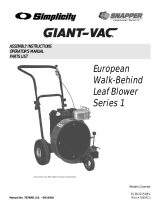
General Use Continued…
Mowing Safety:
WARNING – Gasoline is highly flammable.
• Store fuel in containers specifically designed for this purpose.
• Refuel outdoors only and do not smoke while refueling.
• Add fuel before starting the engine. Never remove the cap of the fuel tank or add gasoline while the engine is
running or when the engine is hot.
• If gasoline is spilled, do not attempt to start the engine but move the machine away from the area of spillage
and avoid creating any source of ignition until gasoline vapors have dissipated.
• Replace all fuel tanks and container caps securely.
Replace faulty or damaged muffler.
Before using, always visually inspect to see that the blades, blade bolts and cutter assembly are not worn or
damaged. Replace worn or damaged blades and bolts in sets to preserve balance.
On multi-bladed machines, take care as rotating one blade can cause other blades to rotate.
Maintenance & Storage:
Keep all nuts, bolts and screws tight to be sure the equipment is in safe working condition.
N
ever store equipment with gasoline in the tank inside a building(s) where fumes can reach an open flame or spark.
Allow the engine to cool before storing in any enclosure.
To reduce the fire hazard, keep the engine, muffler, battery compartment and gasoline in storage area free of grass,
leaves or excessive grease.
Check the grass chute frequently for wear or deterioration.
Replace worn or damaged parts for safety.
If the fuel tank has to be drained, this should be done outdoors in an approved gasoline container and/or properly
disposed of.
When machine is to be parked, stored or left unattended, lower the deck unless a positive mechanical lock is used.
Training:
All drivers should seek and obtain professional and practical instruction. Such instruction should emphasize:
The need for care and concentration when working with ride-on machines.
Control of a ride-on machine sliding on a slope will not be regained by the application of the brake. The main
reasons for loss of control are:
• Insufficient wheel grip.
• Being driven too fast.
• Inadequate braking.
• The type of machine is unsuitable for its task.
• Lack of awareness of the effect of ground conditions, especially slopes.
• Incorrect hitching and load distribution.
Operation:
Do not operate the engine in a confined space where dangerous carbon monoxide fumes can collect.
When using any attachments, never direct discharge of material toward bystanders nor allow anyone near the
machine while in operation.
Never operate the machine with defective guards or without safety protective devices in place.
Do not change the engine governor settings or over-speed the engine. Operating the engine at excessive speed can
increase the hazard of personal injury.
Disengage drive to attachments, stop the engine and disconnect the spark plug wire(s) or remove the ignition key:
• Before clearing blockages or unclogging chute.
• Before checking, clearing or working on the machine.
• After striking a foreign object, inspect the machine for damage and make repairs before restarting and
operating the equipment.
• If the machine starts to vibrate abnormally (check immediately), stop the engine and disengage drive to
attachment.
• Before refueling.
• Before removing the grass chute.
• Before making height adjustment unless adjustment can be made from the operator’s position.
9
9
SAFETY INSTRUCTIONS




















